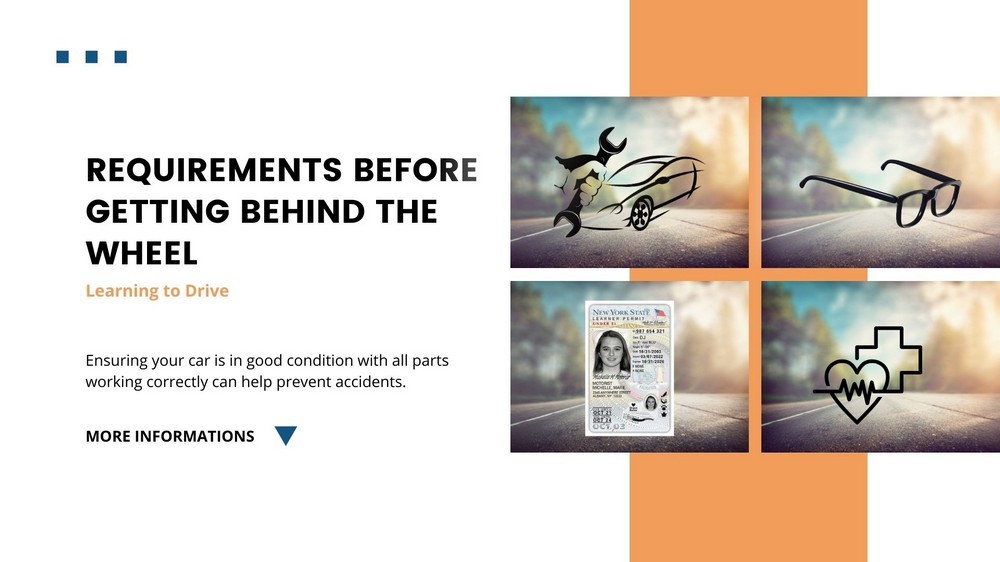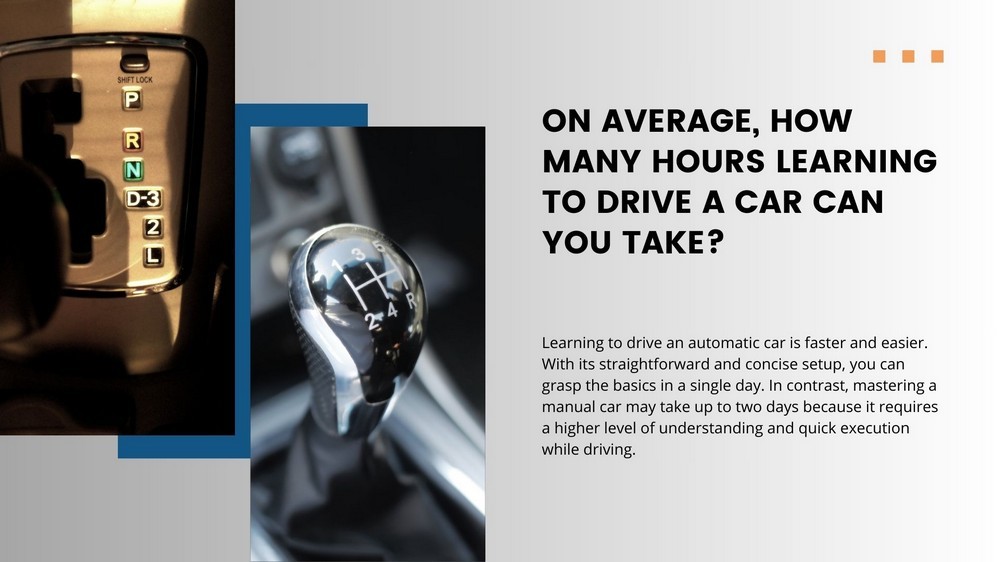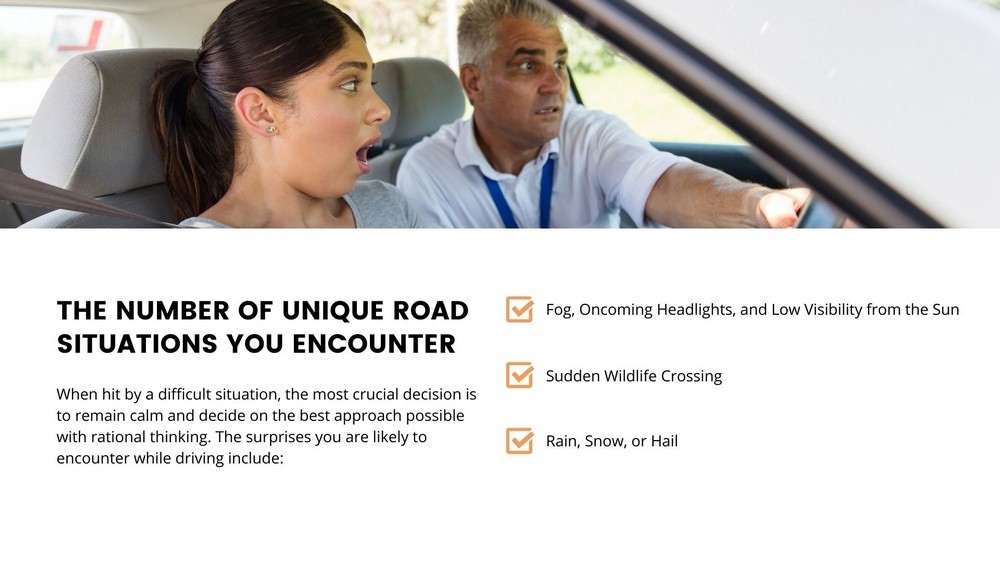Can You Learn Driving In A Month? Absolutely! LEARNS.EDU.VN believes that while mastering the art of driving takes time and practice, you can indeed acquire the fundamental skills within a month with focused effort and the right approach. We’ll guide you through the essential steps, provide expert tips, and highlight key factors influencing your learning speed to help you achieve your driving goals quickly and safely.
1. Understanding the Factors Influencing Your Learning Timeline
Several elements contribute to how quickly you can learn to drive. Understanding these factors allows you to tailor your learning strategy for optimal results.
1.1 Individual Aptitude and Prior Experience
Some individuals possess a natural aptitude for driving, quickly grasping concepts and demonstrating coordination. Prior experience with similar activities, like cycling or operating machinery, can also accelerate the learning process.
1.2 Age of the Learner
While younger learners often exhibit faster reflexes and adaptability, adult learners typically bring a greater sense of responsibility and awareness to the process. Both age groups possess unique advantages.
1.3 Frequency of Lessons and Practice
Consistency is key. Regular lessons and practice sessions, even if they’re short, contribute to better retention and skill development.
1.4 Type of Instruction (Professional vs. Informal)
Professional driving instructors provide structured lessons, covering essential skills and knowledge in a systematic manner. Informal instruction from family or friends can supplement professional training, but it’s crucial to ensure they adhere to safe driving practices.
1.5 Vehicle Transmission Type (Manual vs. Automatic)
Automatic transmissions are generally easier to learn, as they eliminate the need for clutch control and gear shifting. However, learning on a manual transmission provides a more comprehensive understanding of vehicle mechanics.
2. Defining Your Learning Goals
Before embarking on your driving journey, it’s essential to define your specific goals. What do you want to achieve within a month?
2.1 Basic Car Control
Mastering the fundamental controls, including steering, acceleration, braking, and gear shifting (if applicable).
2.2 Confidence in Basic Maneuvers
Confidently performing essential maneuvers, such as starting, stopping, turning, and parking.
2.3 Introduction to Various Road Types
Gaining experience driving on different road types, including residential streets, highways, and intersections.
2.4 Understanding Traffic Laws and Regulations
Familiarizing yourself with local traffic laws, road signs, and safe driving practices.
3. Crafting Your One-Month Driving Plan
Here’s a sample schedule to guide you in your quest to learn driving in a month. Remember to adapt the timeline according to your learning pace and availability.
3.1 Week 1: Foundations and Basic Controls
- Day 1-2: Obtain a learner’s permit and familiarize yourself with the vehicle’s controls (steering wheel, pedals, gear shift).
- Day 3-4: Practice starting, stopping, and steering in a safe, open area, like an empty parking lot.
- Day 5-7: Take professional driving lessons, focusing on basic vehicle control and road positioning.
3.2 Week 2: Essential Maneuvers and Road Awareness
- Day 8-10: Practice turning, lane changing, and basic parking maneuvers in low-traffic areas.
- Day 11-12: Learn to use turn signals, mirrors, and blind spot checks effectively.
- Day 13-14: Continue professional driving lessons, incorporating essential maneuvers and road awareness techniques.
3.3 Week 3: Driving in Traffic and Complex Scenarios
- Day 15-17: Practice driving in moderate traffic, focusing on maintaining a safe following distance and anticipating potential hazards.
- Day 18-19: Learn to navigate intersections, roundabouts, and other complex road scenarios.
- Day 20-21: Continue professional driving lessons, focusing on traffic management and hazard perception.
3.4 Week 4: Refinement and Test Preparation
- Day 22-24: Practice advanced maneuvers, such as parallel parking and three-point turns.
- Day 25-26: Review traffic laws, road signs, and safe driving practices.
- Day 27-28: Take mock driving tests to simulate the actual testing environment.
- Day 29-30: Focus on areas needing improvement based on mock test results and instructor feedback.
4. Maximizing Your Learning Experience
To make the most of your one-month driving journey, consider these additional tips:
4.1 Find a Qualified Driving Instructor
Choose an instructor with experience, patience, and a teaching style that suits your learning preferences. A certified instructor will guide you with effective methodologies.
4.2 Supplement Professional Lessons with Private Practice
Practice driving with a licensed driver in a safe environment to reinforce skills learned during lessons. This enhances your expertise and builds your competence.
4.3 Utilize Online Resources and Driving Simulators
Online resources, like LEARNS.EDU.VN, offer valuable information on traffic laws, safe driving practices, and test preparation. Driving simulators can provide a safe and controlled environment to practice various scenarios.
4.4 Stay Focused and Maintain a Positive Attitude
Learning to drive can be challenging, but maintaining a positive attitude and staying focused on your goals will help you overcome obstacles and accelerate your progress.
4.5 Prioritize Safety
Always prioritize safety, both for yourself and others on the road. Follow traffic laws, drive defensively, and never drive under the influence of alcohol or drugs.
5. Navigating the Legal Landscape
Before you start your driving journey, it’s crucial to understand the legal requirements in your area.
5.1 Learner’s Permit Requirements
Most jurisdictions require you to obtain a learner’s permit before you can begin practicing driving. This typically involves passing a written test and a vision test.
5.2 Age Restrictions
The minimum age to obtain a learner’s permit and a driver’s license varies by location. Check your local regulations for specific age requirements.
5.3 Supervised Driving Regulations
When practicing with a learner’s permit, you must be accompanied by a licensed driver who meets specific requirements, such as age and driving experience.
5.4 Vehicle Requirements
If you’re using your own vehicle for practice, ensure it meets all legal requirements, including registration, insurance, and safety standards.
6. Overcoming Common Challenges
Learning to drive can present various challenges, but understanding how to overcome them will help you stay on track.
6.1 Anxiety and Nervousness
Many new drivers experience anxiety and nervousness, especially when driving in traffic or complex situations. Practice relaxation techniques, such as deep breathing, to manage your anxiety.
6.2 Difficulty with Specific Maneuvers
Certain maneuvers, like parallel parking, can be particularly challenging for new drivers. Break down the maneuver into smaller steps and practice each step individually.
6.3 Fear of Making Mistakes
Everyone makes mistakes when learning to drive. Don’t let the fear of making mistakes hold you back. Learn from your errors and focus on improving your skills.
6.4 Pressure from Others
Avoid feeling pressured by others to drive faster or take unnecessary risks. Drive at your own pace and prioritize safety above all else.
7. Decoding the Average Time to Learn Driving
Understanding the typical timeline for learning to drive can help set realistic expectations. However, it’s important to remember that everyone’s learning journey is unique.
7.1 General Timeframe
According to the Driver and Vehicle Standards Agency (DVSA), the average learner requires approximately 67 total hours of driving experience before being ready for the practical test.
7.2 Factors Influencing Learning Speed
Several factors can affect how quickly you learn to drive:
- Prior Experience: Those familiar with road rules or who have driven other vehicles (e.g., bicycles, motorcycles) may learn faster.
- Frequency of Lessons: Regular, consistent practice often leads to quicker progress.
- Natural Aptitude: Some individuals may have a natural inclination towards driving skills.
- Age: Younger learners often pick up skills quickly, but older learners may have more road awareness.
- Vehicle Type: Automatic transmissions are typically easier to master than manual.
8. Can I Learn Driving In a Week?
While it’s technically possible to grasp basic car control in a week, becoming a safe and competent driver takes considerably longer. Here’s a realistic breakdown:
| Timeframe | Achievable Skills |
|---|---|
| 1 Week | Basic car controls, starting, stopping |
| 1 Month | Confidence in basic maneuvers, introduction to various road types |
| 3 Months | Competence in most driving situations, preparing for practical test |
| 6+ Months | Developing advanced skills, hazard perception, and road awareness |



8.1 Automatic vs. Manual Transmission
Learning on an automatic transmission typically takes less time:
- Automatic: Average 20-30 hours of lessons
- Manual: Average 30-40 hours of lessons
However, a license obtained with an automatic car may restrict you to driving only automatic vehicles in some countries.
9. The Importance of Supervised Practice
Private practice offers several benefits:
- Cost-Effective: Reduces the total number of paid lessons needed
- Diverse Experience: Exposure to different driving conditions and situations
- Confidence Building: Increases comfort level behind the wheel
9.1 Tips for Effective Practice Sessions
- Plan Your Route: Start with quieter areas and gradually progress to more challenging environments
- Set Clear Goals: Focus on specific skills during each practice session
- Stay Calm: Both the learner and supervisor should remain patient and composed
- Reflect and Review: Discuss the session afterwards, identifying areas for improvement
Safety First: Ensure you have proper learner’s insurance and display L-plates (or equivalent) during private practice sessions.
10. Road Situations You Should Experience As a New Driver
New drivers should aim to experience a wide variety of driving scenarios:
- Urban driving
- Rural roads
- Highway/motorway driving
- Night driving
- Driving in adverse weather conditions
- Heavy traffic situations
- Navigating complex intersections and roundabouts
11. A Glimpse Into The Theory of Good Driving
Understanding the theoretical aspects of driving is crucial for becoming a safe and competent driver. This knowledge forms the foundation upon which practical skills are built.
11.1 Understanding Traffic Rules and Regulations
- Road Signs and Markings: Learn to recognize and interpret various signs and road markings.
- Right of Way: Understand who has priority in different traffic situations.
- Speed Limits: Know the standard and situational speed limits for different road types.
11.2 Developing Situational Awareness
Situational awareness is a critical skill for safe driving:
- Scanning Technique: Regularly check mirrors and blind spots.
- Anticipation: Predict potential hazards and other road users’ actions.
- Weather Considerations: Adjust driving style based on weather conditions.
12. Mastering The Art of Driving a Manual Car
Learning to drive a manual transmission car typically takes longer than an automatic:
- Additional Skills: Clutch control, gear changing
- Coordination: Requires more simultaneous actions
- Stalling: Risk of stalling, especially for beginners
However, manual cars offer:
- Greater control over the vehicle
- Often better fuel efficiency
- The ability to drive both manual and automatic cars
13. Choosing The Right Driving Instructor For You
Selecting the right driving instructor can significantly impact your learning experience and overall success.
13.1 Qualifications to Look For
- Certified Instructor: Ensure they’re approved by the relevant authority (e.g., ADI in the UK, state-certified in the US)
- Experience: Consider how long they’ve been teaching
- Pass Rates: Ask about their students’ success rates
13.2 Importance of Teaching Style and Compatibility
- Communication Style: Clear, patient explanations
- Adaptability: Tailors lessons to your learning pace
- Feedback Approach: Constructive criticism balanced with encouragement
14. FAQs About Learning to Drive
14.1 Can I learn to drive in a month?
Yes, it is possible to learn the basics of driving in a month with consistent effort and the right resources.
14.2 How many hours of driving lessons do I need?
The average learner requires approximately 45 hours of professional driving lessons, but this can vary depending on individual learning speed and other factors.
14.3 Is it easier to learn on an automatic or manual car?
Automatic cars are generally easier to learn on as they eliminate the need for clutch control and gear shifting.
14.4 What are the essential skills I need to learn?
Essential skills include basic vehicle control, road positioning, observations, maneuvers, traffic management, and hazard perception.
14.5 How can I find a good driving instructor?
Look for certified instructors with experience, good communication skills, and positive reviews.
14.6 What should I expect on the driving test?
Expect an eyesight check, vehicle safety questions, and approximately 40 minutes of assessed driving, including various road types and traffic conditions.
14.7 What are the common reasons for failing the driving test?
Common reasons for failure include observation errors, inappropriate speed, poor positioning, failure to obey traffic signs, and lack of control.
14.8 How can I stay safe as a new driver?
Avoid distractions, implement a personal curfew, know your limits, and maintain your vehicle regularly.
14.9 What should I do after passing the driving test?
Continue to gain experience, consider taking advanced driving courses, and always prioritize safety.
14.10 What are some tips for faster learning?
Use driving simulators or video resources, study traffic rules and road signs, practice mental rehearsal, and maximize lesson efficiency.
15. Ready to Ace Your Driving Journey?
Are you ready to take the wheel and embark on your driving adventure? Remember, with the right approach, dedication, and resources like those available at LEARNS.EDU.VN, you can achieve your driving goals within a month!
Discover more valuable tips, comprehensive guides, and expert advice by visiting LEARNS.EDU.VN today. Let’s steer you towards success on the road!
Remember, LEARNS.EDU.VN is your go-to resource for mastering driving skills. Our platform offers detailed articles, step-by-step guides, and expert advice to help you become a confident and safe driver. Whether you’re just starting out or looking to refine your skills, LEARNS.EDU.VN has everything you need.
Don’t wait—start your journey towards driving excellence with LEARNS.EDU.VN today. Visit our website and unlock a wealth of knowledge that will transform you into a skilled and responsible driver.
Contact us:
- Address: 123 Education Way, Learnville, CA 90210, United States
- WhatsApp: +1 555-555-1212
- Website: LEARNS.EDU.VN
Start your safe driving journey with us and experience the best in driver education. Let learns.edu.vn be your trusted partner in achieving your driving dreams.
